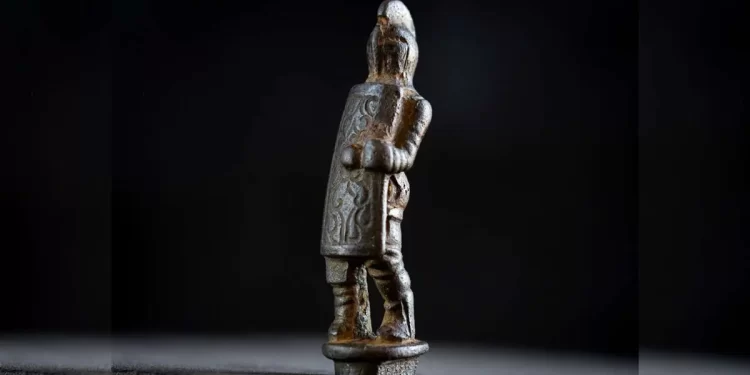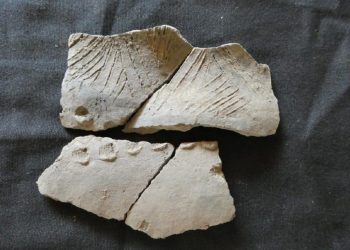The discovery of a rare Roman-era knife handle in the River Tyne near Corbridge Roman Town, England, offers a striking glimpse into the expansive cultural influence of the Roman Empire. Intricately crafted from copper-alloy and shaped like a gladiator, this artifact has captured the imagination of historians and the public alike.
Gladiatorial games were a hallmark of Roman society, captivating audiences across the empire from 105 BCE to 404 CE. These events, which combined brutal combat with theatrical spectacle, were staged in amphitheaters and served as both entertainment and a display of the ruling elite’s power. While the Colosseum in Rome remains the most famous venue, evidence of such spectacles spans the empire, including Britain’s northern frontier.
The knife handle, dated to approximately 2,000 years ago, depicts a secutor—a heavily armored gladiator known for engaging in close combat against a retiarius, a net-wielding adversary. Remarkably, the figurine shows the gladiator holding his weapon in his left hand, a historically significant detail as left-handedness was considered inauspicious in ancient Rome. Scholars believe this unique depiction might honor a real gladiator celebrated for overcoming such stigma.
Gladiators as Celebrities and Symbols
Dr. Frances McIntosh, Collections Curator for English Heritage, described the find as “particularly remarkable” due to its preservation and rarity in Britain. She noted the cultural significance of gladiators, saying, “Despite their status as enslaved individuals, gladiators were cultural icons, capable of achieving celebrity status in Roman society.”
Indeed, the fascination with gladiators transcended the arena. These fighters inspired a range of consumer goods, from ceramics and lamps to intricate figurines like this knife handle. Their allure even extended to Rome’s elite women, some of whom were captivated by the charisma of these lowly yet powerful warriors.
Corbridge: A Window into Roman Britain
The location of the find, Corbridge Roman Town, was a bustling supply hub for Hadrian’s Wall during the height of the Roman Empire. Known as Corstopitum in antiquity, the site played a crucial role in the defense and administration of the empire’s northernmost territories. Artifacts recovered from the River Tyne, including this knife handle and a painted glass fragment featuring a leopard—likely part of a scene depicting animal hunts—shed light on the vibrant cultural life of Roman Britain.
The allure of gladiators persists in modern culture, exemplified by the enduring popularity of films like Gladiator and its much-anticipated sequel. Dr. McIntosh highlighted this continuity, remarking, “Even now, almost 2,000 years later, the fascination with gladiators remains strong.”
English Heritage plans to display the knife handle alongside other artifacts from the river at Corbridge Roman Town in 2025. This exhibit will provide visitors with a vivid connection to the past, showcasing the artistry and societal dynamics that shaped Roman Britain.











